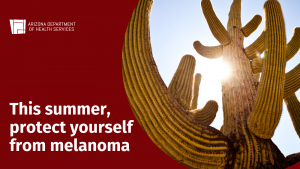 Few things go together more than Arizona and sunshine. Yuma, Tucson, and Phoenix are among American cities with the most sunny days, but many places across our state see abundant sunshine.
Few things go together more than Arizona and sunshine. Yuma, Tucson, and Phoenix are among American cities with the most sunny days, but many places across our state see abundant sunshine.
All that sun brings with it an increased risk of melanoma, a deadly form of skin cancer that is increasingly common in Arizona. From 2014 to 2018, Arizona saw a 58% increase in reported melanoma cases. It is the fifth most-common cancer in our state.
With summer quickly approaching, this is a good time to understand the things that increase your risk of melanoma and what you can do to protect yourself. Sunburns today increase the potential for melanoma years from now. Kids are among those at risk.
Melanoma can develop at any age, but 60% of cases and 69% deaths occur in those age 65 and older, with 86% of cases and 91% of deaths occurring in those older than 50. Melanoma is more common in men among those over 50 but more common among women for ages 20-50. Arizonans who identify as White are five times more likely to develop melanoma than Hispanic/Latino individuals and 20 times more likely than Black individuals.
The highest rates of melanoma in Arizona are in Yavapai, Pima, and Maricopa counties; the lowest rates are in Yuma, Apache, Santa Cruz, and Navajo counties.
The exact cause of all melanomas is not clear, but exposure to ultraviolet radiation – from sunlight to tanning beds – increases your risk. Other risk factors include having a large number of moles, having light hair or light eyes, and having a family history of melanoma, breast, or pancreatic cancer.
According to the Centers for Disease Control and Prevention, these steps will help protect you:
- Stay in the shade.
- Wear clothing that covers your arms and legs.
- Wear a hat with a wide brim to shade your face, head, ears, and neck.
- Wear sunglasses that wrap around and block both UVA and UVB rays.
- Use a broad spectrum sunscreen with a sun protection factor (SPF) of 15 or higher.
- Avoid indoor tanning.
The ADHS SunWise Skin Cancer Prevention School Program provides free curriculum, school assemblies, staff training, and resources to reduce skin cancer. These fun-filled activities average 20 minutes in length and are divided into different age groups. Minimal time is required to implement a SunWise School Program, while the lasting effects of UV protection and reduced skin cancer deaths in Arizona are immeasurable.
The 2022 program, Be SunWise & Play Sun Smart, included a poster contest. The winners this year are Sophia Gonzalez and Audrey Conn of Continental School in Green Valley and Mohammed Aili Abdul Ahmad of Sunset Ridge Elementary in Glendale.










